SLVSDD0B May 2016 – September 2017 TPS22975
PRODUCTION DATA.
- 1 Features
- 2 Applications
- 3 Description
- 4 Revision History
- 5 Device Comparison Table
- 6 Pin Configuration and Functions
- 7 Specifications
- 8 Parameter Measurement Information
- 9 Detailed Description
- 10Application and Implementation
- 11Power Supply Recommendations
- 12Layout
- 13Device and Documentation Support
- 14Mechanical, Packaging, and Orderable Information
7 Specifications
7.1 Absolute Maximum Ratings
Over operating free-air temperature range (unless otherwise noted)(1)| MIN | MAX | UNIT | |||
|---|---|---|---|---|---|
| VIN | Input voltage | –0.3 | 6 | V | |
| VOUT | Output voltage | –0.3 | 6 | V | |
| VBIAS | Bias voltage | –0.3 | 6 | V | |
| VON | On voltage | –0.3 | 6 | V | |
| IMAX | Maximum continuous switch current | 6 | A | ||
| IPLS | Maximum pulsed switch current, pulse < 300 µs, 2% duty cycle | 8 | A | ||
| TJ | Maximum junction temperature | 125 | °C | ||
| Tstg | Storage temperature | –65 | 150 | °C | |
(1) Stresses beyond those listed under Absolute Maximum Ratings may cause permanent damage to the device. These are stress ratings only, which do not imply functional operation of the device at these or any other conditions beyond those indicated under Recommended Operating Conditions. Exposure to absolute-maximum-rated conditions for extended periods may affect device reliability.
7.2 ESD Ratings
| VALUE | UNIT | |||
|---|---|---|---|---|
| V(ESD) | Electrostatic discharge | Human-body model (HBM), per ANSI/ESDA/JEDEC JS-001(1) | ±2000 | V |
| Charged-device model (CDM), per JEDEC specification JESD22-C101(2) | ±1000 | |||
(1) JEDEC document JEP155 states that 500-V HBM allows safe manufacturing with a standard ESD control process.
(2) JEDEC document JEP157 states that 250-V CDM allows safe manufacturing with a standard ESD control process.
7.3 Recommended Operating Conditions
| MIN | MAX | UNIT | |||
|---|---|---|---|---|---|
| VIN | Input voltage | 0.6 | VBIAS | V | |
| VBIAS | Bias voltage | 2.5 | 5.7 | V | |
| VON | ON voltage | 0 | 5.7 | V | |
| VOUT | Output voltage | VIN | V | ||
| VIH | High-level input voltage, ON | VBIAS = 2.5 V to 5 V, TA< 85°C | 1.05 | 5.7 | V |
| VBIAS = 2.5 V to 5 V, TA< 105°C | 1.1 | 5.7 | |||
| VBIAS = 5 V to 5.7 V, TA< 105°C | 1.2 | 5.7 | |||
| VIL | Low-level input voltage, ON | VBIAS = 2.5 V to 5.7 V | 0 | 0.5 | V |
| CIN | Input capacitor | 1(1) | µF | ||
| TA | Operating free-air temperature(1)(2) | –40 | 105 | °C | |
(1) See the Application Information section.
(2) In applications where high power dissipation and-or poor package thermal resistance is present, the maximum ambient temperature may have to be derated and device lifetime may be affected. Maximum ambient temperature (TA(max)) is dependent on the maximum operating junction temperature (TJ(max)), the maximum power dissipation of the device in the application (PD(max)), and the junction-to-ambient thermal resistance of the part-package in the application (θJA), and can be approximated by the following equation: TA (max) = TJ(max) – (θJA × PD(max)).
7.4 Thermal Information
| THERMAL METRIC(1) | TPS22975 | UNIT | |
|---|---|---|---|
| DSG (WSON) | |||
| 8 PINS | |||
| RθJA | Junction-to-ambient thermal resistance | 74.8 | °C/W |
| RθJC(top) | Junction-to-case (top) thermal resistance | 81 | °C/W |
| RθJB | Junction-to-board thermal resistance | 44.7 | °C/W |
| ψJT | Junction-to-top characterization parameter | 3.9 | °C/W |
| ψJB | Junction-to-board characterization parameter | 45.1 | °C/W |
| RθJC(bot) | Junction-to-case (bottom) thermal resistance | 16.4 | °C/W |
(1) For more information about traditional and new thermal metrics, see the Semiconductor and IC Package Thermal Metrics application report.
7.5 Electrical Characteristics—VBIAS = 5 V
Unless otherwise noted, the specifications in the following table applies where VBIAS = 5 V. Typical values are for TA = 25 °C.| PARAMETER | TEST CONDITIONS | TA | MIN | TYP | MAX | UNIT | ||
|---|---|---|---|---|---|---|---|---|
| POWER SUPPLIES AND CURRENTS | ||||||||
| IQ, VBIAS | VBIAS quiescent current | IOUT = 0 A, VIN = VON = 5 V |
–40°C to +105°C | 37 | 45 | µA | ||
| ISD, VBIAS | VBIAS shutdown current | VON = VOUT = 0 V | –40°C to +105°C | 2.3 | µA | |||
| ISD, VIN | VIN off-state supply current | VON = VOUT = 0 V | VIN = 5 V | –40°C to +85°C | 0.005 | 5 | µA | |
| –40°C to +105°C | 10 | |||||||
| VIN = 3.3 V | –40°C to +85°C | 0.002 | 1.5 | |||||
| –40°C to +105°C | 3.5 | |||||||
| VIN = 1.8 V | –40°C to +85°C | 0.002 | 1 | |||||
| –40°C to +105°C | 2 | |||||||
| VIN = 0.6 V | –40°C to +85°C | 0.001 | 0.5 | |||||
| –40°C to +105°C | 1 | |||||||
| ION | On-pin input leakage current | VON = 5.5 V | –40°C to +105°C | 0.1 | µA | |||
| RESISTANCE CHARACTERISTICS | ||||||||
| RON | On-resistance | IOUT = –200 mA | VIN = 5 V | 25°C | 16 | 19 | mΩ | |
| –40°C to +85°C | 23 | |||||||
| –40°C to +105°C | 25 | |||||||
| VIN = 3.3 V | 25°C | 16 | 19 | |||||
| –40°C to +85°C | 23 | |||||||
| –40°C to +105°C | 25 | |||||||
| VIN = 1.8 V | 25°C | 16 | 19 | |||||
| –40°C to +85°C | 23 | |||||||
| –40°C to +105°C | 25 | |||||||
| VIN = 1.5 V | 25°C | 16 | 19 | |||||
| –40°C to +85°C | 23 | |||||||
| –40°C to +105°C | 25 | |||||||
| VIN = 1.05 V | 25°C | 16 | 19 | |||||
| –40°C to +85°C | 23 | |||||||
| –40°C to +105°C | 25 | |||||||
| VIN = 0.6 V | 25°C | 16 | 19 | |||||
| –40°C to +85°C | 23 | |||||||
| –40°C to +105°C | 25 | |||||||
| VON, HYS | On-pin hysteresis | VIN = 5 V | 25°C | 120 | mV | |||
| RPD (1) | Output pulldown resistance | VIN = 5 V, VON = 0 V | –40°C to +105°C | 230 | 300 | Ω | ||
| TSD | Thermal shutdown | Junction temperature rising | 160 | °C | ||||
| TSD, HYS | Thermal shutdown hysteresis | Junction temperature falling | 20 | °C | ||||
(1) TPS22975 only
7.6 Electrical Characteristics—VBIAS = 2.5 V
Unless otherwise noted, the specifications in the following table applies where VBIAS = 2.5 V. Typical values are for TA = 25 °C.| PARAMETER | TEST CONDITIONS | TA | MIN | TYP | MAX | UNIT | ||
|---|---|---|---|---|---|---|---|---|
| POWER SUPPLIES AND CURRENTS | ||||||||
| IQ, VBIAS | VBIAS quiescent current | IOUT = 0 mA, VIN = VON = 2.5 V |
–40°C to +105°C | 14 | 20 | µA | ||
| ISD, VBIAS | VBIAS shutdown current | VON = VOUT = 0 V | –40°C to +105°C | 1 | µA | |||
| ISD, VIN | VIN off-state supply current | VON = VOUT = 0 V | VIN = 2.5 V | –40°C to +85°C | 0.005 | 1.3 | µA | |
| –40°C to +105°C | 2.6 | |||||||
| VIN = 1.8 V | –40°C to +85°C | 0.002 | 1 | |||||
| –40°C to +105°C | 2 | |||||||
| VIN = 1.05 V | –40°C to +85°C | 0.002 | 0.8 | |||||
| –40°C to +105°C | 1.5 | |||||||
| VIN = 0.6 V | –40°C to +85°C | 0.001 | 0.5 | |||||
| –40°C to +105°C | 1 | |||||||
| ION | On-pin input leakage current | VON = 5.5 V | –40°C to +105°C | 0.1 | µA | |||
| RESISTANCE CHARACTERISTICS | ||||||||
| RON | On-resistance | IOUT = –200 mA | VIN = 2.5 V | 25°C | 20 | 26 | mΩ | |
| –40°C to +85°C | 32 | |||||||
| –40°C to +105°C | 34 | |||||||
| VIN = 1.8 V | 25°C | 18 | 23 | |||||
| –40°C to +85°C | 29 | |||||||
| –40°C to +105°C | 31 | |||||||
| VIN = 1.5 V | 25°C | 18 | 22 | |||||
| –40°C to +85°C | 28 | |||||||
| –40°C to +105°C | 30 | |||||||
| VIN = 1.2 V | 25°C | 17 | 22 | |||||
| –40°C to +85°C | 27 | |||||||
| –40°C to +105°C | 29 | |||||||
| VIN = 0.6 V | 25°C | 17 | 21 | |||||
| –40°C to +85°C | 26 | |||||||
| –40°C to +105°C | 27 | |||||||
| VON, HYS | On-pin hysteresis | VIN = 2.5 V | 25°C | 85 | mV | |||
| RPD(1) | Output pulldown resistance | VIN = 2.5 V, VON = 0 V | –40°C to +105°C | 230 | 330 | Ω | ||
| TSD | Thermal shutdown | Junction temperature rising | 160 | °C | ||||
| TSD, HYS | Thermal shutdown hysteresis | Junction temperature falling | 20 | °C | ||||
(1) TPS22975 only
7.7 Switching Characteristics
| PARAMETER | TEST CONDITION | MIN | TYP | MAX | UNIT | |
|---|---|---|---|---|---|---|
| VIN = VBIAS = 5 V, TA = 25ºC (unless otherwise noted) | ||||||
| tON | Turnon time | RL = 10 Ω, CL = 0.1 µF, CIN = 1 µF, CT = 1000 pF, VON = 5 V | 1450 | µs | ||
| tOFF | Turnoff time | RL = 10 Ω, CL = 0.1 µF, CIN = 1 µF, CT = 1000 pF, VON = 5 V | 2 | |||
| tR | VOUT rise time | RL = 10 Ω, CL = 0.1 µF, CIN = 1 µF, CT = 1000 pF, VON = 5 V | 1750 | |||
| tF | VOUT fall time | RL = 10 Ω, CL = 0.1 µF, CIN = 1 µF, CT = 1000 pF, VON = 5 V | 2 | |||
| tD | ON delay time | RL = 10 Ω, CL = 0.1 µF, CIN = 1 µF, CT = 1000 pF, VON = 5 V | 600 | |||
| VIN = 0.6 V, VBIAS = 5 V, TA = 25ºC (unless otherwise noted) | ||||||
| tON | Turnon time | RL = 10 Ω, CL = 0.1 µF, CIN = 1 µF, CT = 1000 pF, VON = 5 V | 620 | µs | ||
| tOFF | Turnoff time | RL = 10 Ω, CL = 0.1 µF, CIN = 1 µF, CT = 1000 pF, VON = 5 V | 2 | |||
| tR | VOUT rise time | RL = 10 Ω, CL = 0.1 µF, CIN = 1 µF, CT = 1000 pF, VON = 5 V | 280 | |||
| tF | VOUT fall time | RL = 10 Ω, CL = 0.1 µF, CIN = 1 µF, CT = 1000 pF, VON = 5 V | 2 | |||
| tD | ON delay time | RL = 10 Ω, CL = 0.1 µF, CIN = 1 µF, CT = 1000 pF, VON = 5 V | 485 | |||
| VIN = VBIAS = 2.5 V, TA = 25ºC (unless otherwise noted) | ||||||
| tON | Turnon time | RL = 10 Ω, CL = 0.1 µF, CIN = 1 µF, CT = 1000 pF, VON = 5 V | 2180 | µs | ||
| tOFF | Turnoff time | RL = 10 Ω, CL = 0.1 µF, CIN = 1 µF, CT = 1000 pF, VON = 5 V | 2 | |||
| tR | VOUT rise time | RL = 10 Ω, CL = 0.1 µF, CIN = 1 µF, CT = 1000 pF, VON = 5 V | 2150 | |||
| tF | VOUT fall time | RL = 10 Ω, CL = 0.1 µF, CIN = 1 µF, CT = 1000 pF, VON = 5 V | 2 | |||
| tD | ON delay time | RL = 10 Ω, CL = 0.1 µF, CIN = 1 µF, CT = 1000 pF, VON = 5 V | 1120 | |||
| VIN = 0.6 V, VBIAS = 2.5 V, TA = 25ºC (unless otherwise noted) | ||||||
| tON | Turnon time | RL = 10 Ω, CL = 0.1 µF, CIN = 1 µF, CT = 1000 pF, VON = 5 V | 1315 | µs | ||
| tOFF | Turnoff time | RL = 10 Ω, CL = 0.1 µF, CIN = 1 µF, CT = 1000 pF, VON = 5 V | 3 | |||
| tR | VOUT rise time | RL = 10 Ω, CL = 0.1 µF, CIN = 1 µF, CT = 1000 pF, VON = 5 V | 650 | |||
| tF | VOUT fall time | RL = 10 Ω, CL = 0.1 µF, CIN = 1 µF, CT = 1000 pF, VON = 5 V | 2 | |||
| tD | ON delay time | RL = 10 Ω, CL = 0.1 µF, CIN = 1 µF, CT = 1000 pF, VON = 5 V | 975 | |||
7.8 Typical DC Characteristics
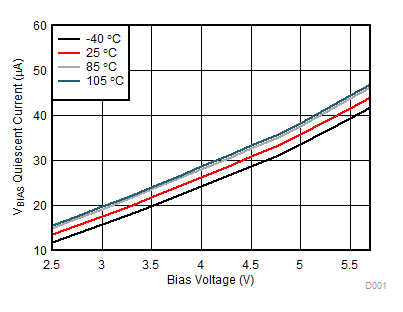
| VIN = VBIAS | VON = 5 V | VOUT = 0 V |
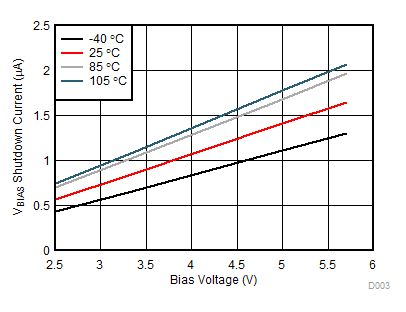
| VIN = VBIAS | VON = 0 V | VOUT = 0 V |

| VBIAS = 5 V | IOUT = –200 mA | VON = 5 V |
| Note: | All three RON curves have the same values; therefore, only one line is visible. | |
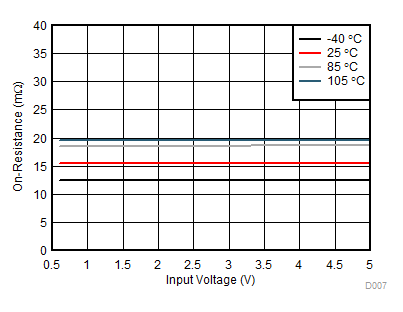
| VBIAS = 5 V | IOUT = –200 mA | VON = 5 V |
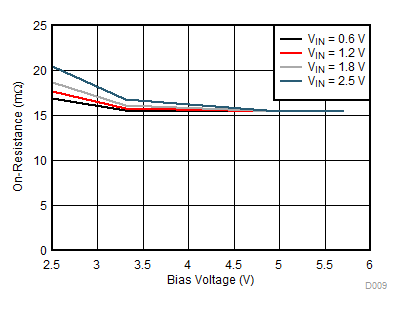
| TA = 25°C | IOUT = –200 mA | VON = 5 V |
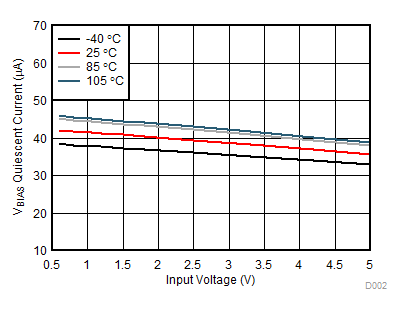
| VBIAS = 5 V | VON = 5 V | VOUT = 0 V |
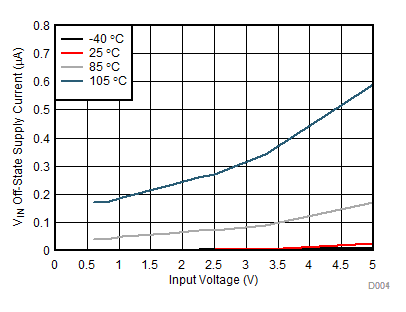
| VBIAS = 5 V | VON = 0 V | VOUT = 0 V |
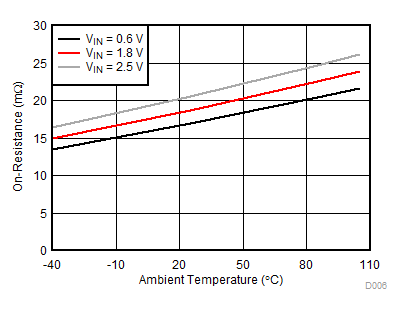
| VBIAS = 2.5 V | IOUT = –200 mA | VON = 5 V |
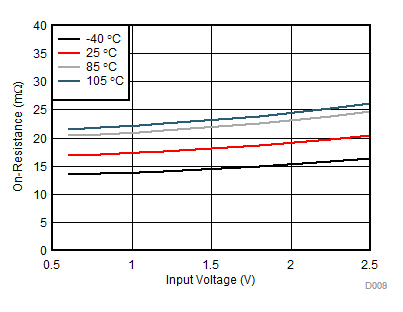
| VBIAS = 2.5 V | IOUT = –200 mA | VON = 5 V |
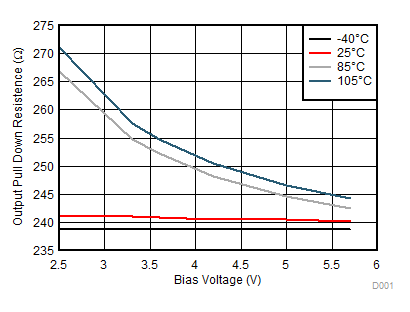
| VIN = 2.5 V | VON = 0 V | |
7.9 Typical AC Characteristics
TA = 25°C, CT = 1000 pF, CIN = 1 µF, CL = 0.1 µF, RL = 10 Ω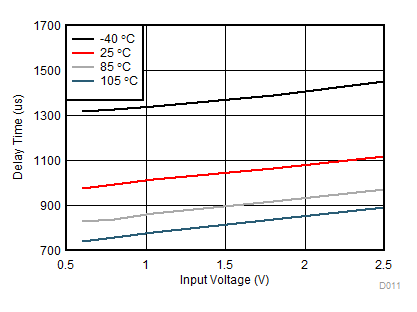
| VBIAS = 2.5 V | ||
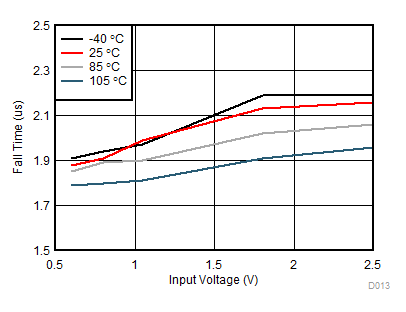
| VBIAS = 2.5 V | ||

| VBIAS = 2.5 V | ||
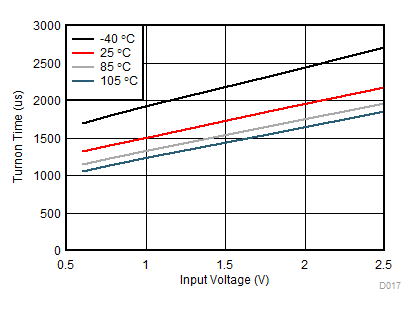
| VBIAS = 2.5 V | ||
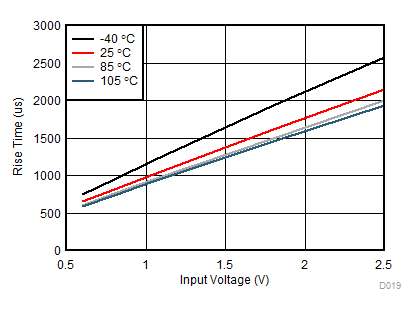
| VBIAS = 2.5 V | ||
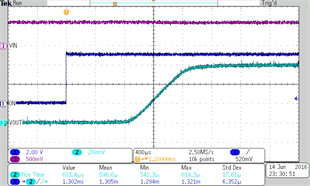
| VIN = 0.6 V | VBIAS = 2.5 V | |
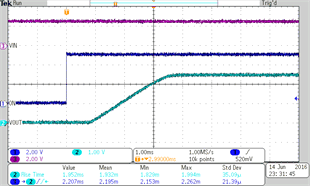
| VIN = 2.5 V | VBIAS = 2.5 V | |
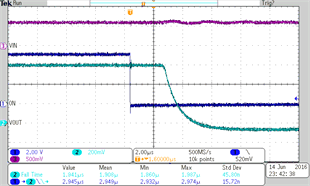
| VIN = 0.6 V | VBIAS = 2.5 V | |
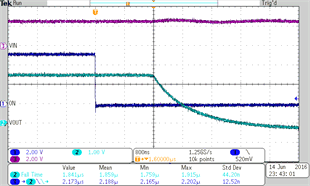
| VIN = 2.5 V | VBIAS = 2.5 V | |
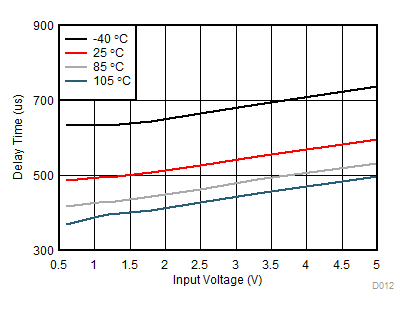
| VBIAS = 5 V | ||
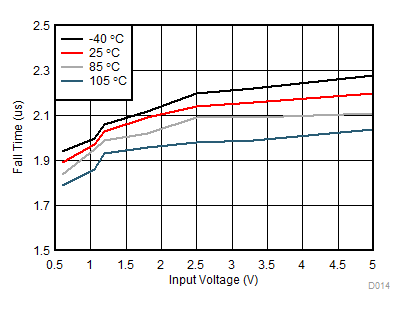
| VBIAS = 5 V | ||
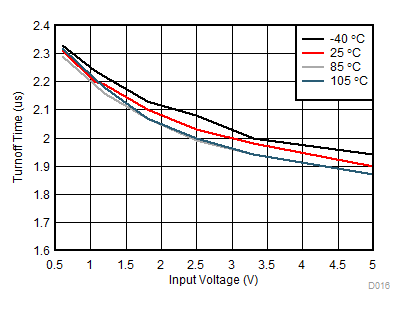
| VBIAS = 5 V | ||
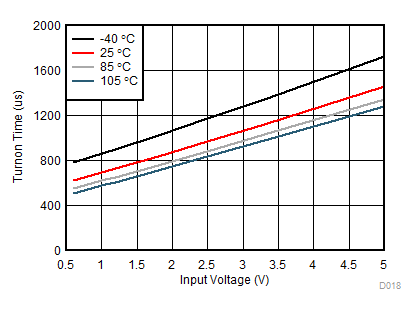
| VBIAS = 5 V | ||
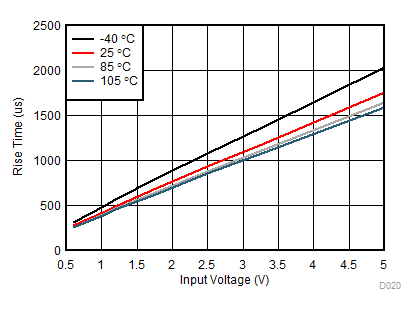
| VBIAS = 5 V | ||
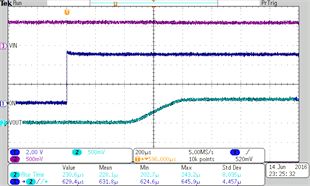
| VIN = 0.6 V | VBIAS = 5 V | |
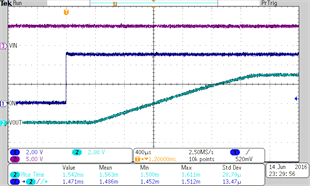
| VIN = 5 V | VBIAS = 5 V | |
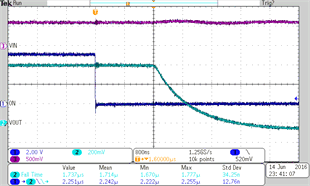
| VIN = 0.6 V | VBIAS = 5 V | |
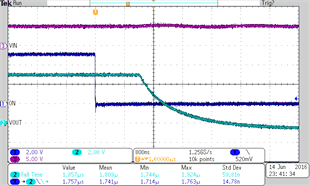
| VIN = 5 V | VBIAS = 5 V | |